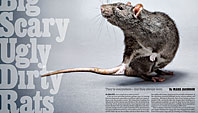
1. An oral history on the early days of pioneering women’s magazine Ms. (which was introduced in New York 40 years ago) brought readers back (“How Do You Spell Ms.,” by Abigail Pogrebin, November 7). “I loved this piece,” tweeted @annierebekah. “The story of Ms. Magazine & its feminist founding is the best entrepreneurship piece I’ve read all week,” wrote @jessunscripted. Commenters on nymag.com also had fond memories of Ms. “I remember that December 1971 issue of New York Magazine. (Of course, by the time it reached the hinterlands, it was January 1972!),” wrote one. “But the opening salvo was shot, and this (then) 15-year-old was impressed.” “Gloria Steinem is an American hero and icon!” applauded another. “It is unfortunate that younger women today do not understand the sacrifices that were made for their future and opportunities.” Other readers took care to point out that the fight isn’t over. “We’ve come a long way, baby, but we’re not done yet! Loved Ms. Magazine, loved to go braless, still rage about women’s rights … Bravo to Ms. Steinem and all the pioneers who have helped paved the way. We just can’t stop now.”
2. But it was Emily Nussbaum’s related essay on the charged, pamphleteering feminist writing found online that got the lion’s share of attention in the issue, not surprisingly (“The Rebirth of the Feminist Manifesto,” November 7). “What’s more fun than a ten-page article on modern feminism?” asked Edith Zimmerman at the Hairpin. “A four-page article on feminist bloggers! … (Jokes aside, both pieces are very good.)” “This is one of the most dynamic pieces written on feminism, race, and the generation gap/digital divide,” tweeted @merchantmenace. At the American Prospect, E. J. Graff called it “the perfect introduction to the new, fiery, sardonic, savvy generation of feminists who are making change online and in the streets.” At Pandagon, Amanda Marcotte, one of the bloggers profiled, praised the scope of the story: “Instead of concentrating on a handful of blogs that get the most traffic, she sees the feminist blogosphere in its entirety,” she wrote. “Which is important, because it’s a remarkable counter to the same tedious story line about how feminism is dead.” “Honestly, because I write for a ladyblog, and reading other ladyblogs is basically what I spend all my time doing, I could find a lot of things not to like about the New York Magazine article,” wrote Jessica Wakeman at The Frisky. “However, I’ve given it more thought, and I’ve come to appreciate it for what it is: an article acknowledging that ladyblogs are a ‘thing,’ that they’re an important thing, and somebody other than our moms is reading our writing. Most importantly, though, this kind of media recognition exposes all of us—the ones mentioned in the article, as well as the ones linked to by the ones mentioned—to more and more readers. It might mean more and more page views. It might mean more and more blog post comments like ‘u r fat go on a diet piggy.’ It might mean more criticism from our peers. But I think—hope?— it will mean more connections for all of us—including myself—from those 16-year-old girls in the suburbs in the Northeast who don’t have to rattle around in their own heads anymore.”

3. The most common response to Mark Jacobson’s picaresque survey of New York’s rat renaissance (“Big Scary Ugly Dirty Rats,” November 7) was disgust, especially on Twitter. “This is officially the most terrifying article I’ve ever read. Thanks for that, @NYMag. You bastards,” wrote @ClaireHoffman. “Have read many articles about NYC rats, but this is The One. Read the 4th paragraph, shudder,” wrote @lexinyt. “Thank you @NYMag for filling my dreams with rats. I knew I should not have read that article past 8PM!” wrote @Swenson51. But some readers, at least, savored the story. “Thanks New York Magazine for the great publicity!” tweeted @ratsofnyc.
Send correspondence to: nymletters@nymag.com